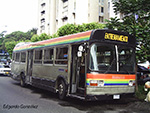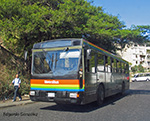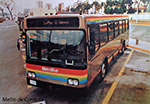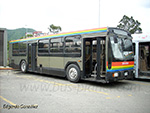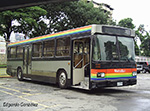Metrobus Caracas Twitter: https://twitter.com/MetroBusOficial
The Metrobus system started operations on 4 October 1987 in order to connect different parts of the city through the Caracas Metro stations. Its fleet of buses at the time was made up of 50 Renault PR100. 2-Autogago and 50 Pegaso 6424- Unicar U-90, all imported, and 13 refurbished Leyland National MK1 dating from 1975, taken over from the former Municipal Institute for Public Transport (IMTC). Later the Leyland fleet was increased to 25 vehicles plus 15 training vehicles. The picture shows the three models at the start of the system in 1987 (picture Metrobus, collection Edgardo Gonzalez).
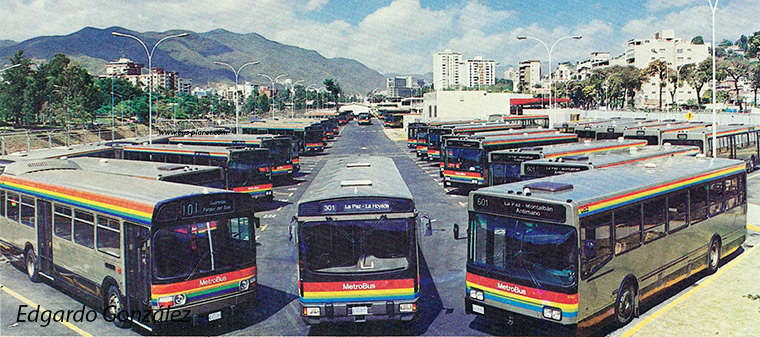
The company started with two routes, the express route that was direct without intermediary stops from the La Paz Metro station to El Silencio and the local route that ran from La Paz to La Hoyada, but with intermediary stops. By the end of 1988, when the construction of the La Paz-El Silencio Metro de Caracas was finished, the first regular route was inaugurated, the 201, Cafetal-Altamira, and soon the second route, 601, La Paz-Montalban-Antimano followed. Nowadays there are almost 40 routes in Caracas. By 1993 the fleet was increased with 50 Renault PR100.2-Autogago and 50-Pegaso 6424 -ENASA. Also, from Brazil a prototype Volvo B10M -Marcopolo Torino G4, which is understood to be a unique bus and even in Brazil none were used. In 1994 the engine and original gearbox of 18 Leyland National MK1 are replaced by DAF Diesel 218 HP engines and ZF automatic transmission. One Leyland National received a Detroit Diesel engine and Allison automatic transmission. During the same year (1994) the delivery of 70 Renault PR100.2 manufactured by Fanaus / Unicar begins.
In 2005 a fleet renewal started with the purchase of 15 Encava E-NT3300, 7 on Mercedes-Benz OH1420 chassis and 8 with Cummins engines. In 2006 the first Volvo B7R with Fanabús model “Rio 3000” were added to the fleet. In 2007 the first Volvo B7R -Busscar Urbanuss Pluss-B7R came. The same year the first social route. La Paz-Perez Carreno Hospital, started with 4 Iveco Daily with CNG engines, bodied by Andean Bodies. In mid-2007 begins the large-scale training of the first women operators (drivers) with Metrobus, the first 24 women graduate that year.
In 2012 the first Yutong ZK6118HGA came, of which 300 are diesel and 100 gas (CNG). In addition there is a smaller number of Yutong ZK6896HGA. On the 3rd of October 2012 the mass transportation system (BRT) Bus Caracas (BusCCS) starts with metrobus drivers, as part of line 7 of the Metro de Caracas, with 30 articulated Yutong ZK6180HGC fuel gas (CNG) buses to which in 2014, Yutong ZK6180HGC diesel buses are added (see BusCCS page).
In 2015 25 Yutong ZK6180HGC low-floor buses were added to the fleet to evaluate the routes on which those buses van be used.
-----------------------------------------
El sistema Metrobus inicia operaciones un 04 de octubre de 1987 con la finalidad de conectar diferentes puntos de la ciudad, a las estaciones del Metro de Caracas. Su flota de autobuses estaba compuesta para ese momento por 50 Renault PR100.2-Autogago y 50 Pegaso 6424-Unicar U-90, todos importados y 13 Leyland National MK1 restaurados, ya que éstos pertenecieron al desaparecido Instituto Municipal del Transporte Colectivo (I.M.T.C.) desde 1975, luego se incrementa a 25 Leyland National.
Comenzaron con dos rutas, La Expresa que iba directo y sin paradas desde la Estación del Metro La Paz hasta El Silencio y la ruta Local que partía desde La Paz hasta La Hoyada, pero dicha ruta tenía paradas, ya a finales de 1988 al concluir la construcción del tramo La Paz-El Silencio del Metro de Caracas, se crea la primera ruta regular, la 201 Cafetal-Altamira y al poco tiempo se crea la segunda ruta 601, La Paz-Montalban-Antimano y así hoy en día cuenta con casi 40 rutas en la ciudad de Caracas
Para 1993 se incrementa la flota con 50 Renault PR100.2-Autogago y 50 Pegaso 6424-Enasa, también se recibe desde Brasil un prototipo Torino G4 de Marcopolo con chasis Volvo B10M, se tiene entendido que es un autobús único a nivel mundial, ni en Brasil los tienen, ademas, en 1994 se le cambia el motor y caja original a 18 Leyland National MK1, por motores DAF Diesel 218HP, caja automatica ZF y a un Leyland National se le adapta un motor Detroit Diesel y caja automatica Allison, a su vez ese mismo año 1994 comienzan a recibir 70 Renault PR100.2 fabricados Fanaus / Unicar
En 2005 el sisetma inicia una renovación de flota con la compra de 15 Encava E-NT3300, de los cuales 7 con chasis Mercedes-Benz OH1420 y 8 con chasis Cummins, en el año 2006 comienzan a recibir los primeros Volvo B7R fabricados por Fanabús cuyo modelo se llama Rio 3000, en 2007 llegan desde Brasil los primeros Busscar Urbanuss Pluss-Volvo B7R y también las 4 Iveco Daily a gas (GNC) y carrozados por Carrocerías Andinas para la primera ruta social, La Paz-Hospital Perez Carreño, tambien a mediados del año 2007, comienza el entrenamiento masivo de las primeras mujeres operadoras (conductoras) del Metrobus, se gradúan las primeras 24 mujeres.
Para 2012 reciben los primeros Yutong ZK6118HGA de los cuales 300 son combustible a gasoil y 100 a gas (GNC), también reciben una pequeña cantidad de Yutong ZK6896HGA y el 03 de octubre personal del Metrobus comienza las operaciones del sistema masivo de Transporte (BRT) Bus Caracas (BusCCS), que forma parte de la línea 7 del Metro de Caracas, con 30 autobuses articulados Yutong ZK6180HGC combustible a gas (GNC) y a finales del pasado año 2014, se añaden 20 Yutong ZK6180HGC a gasoil al sistema BusCCS.
Este año 2015 recibe 25 Yutong ZK6180HGC piso bajo, los cuales se esta evaluando en que rutas seran usados
